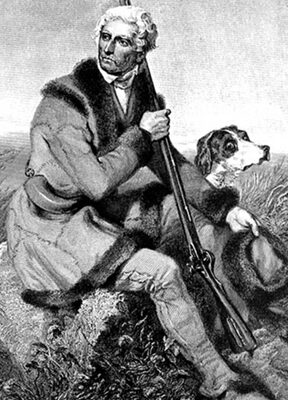My fascination for stories about Daniel Boone and his famous trek through East Tennessee in 1760 have me constantly searching for new information about him. Recently, I found something in a 1918 “Wisconsin Magazine of History” that merits sharing with Press readers.

Mr. C. A. Rafter once donated a most interesting firearm, a flintlock Kentucky rifle of the kind used by hardy pioneers of the 18thcentury, to Wisconsin’s State Historical Museum.
According to historian Emory Hamilton, Long Hunters (aka Longhunters) were brave explorers and huntsman peculiar to Southwest Virginia. Most hunts originated on the Holston River in the vicinity of present day Chilhowie, but were comprised of hunters who lived on both the Clinch and Holston rivers.
These courageous souls were native landowners and residents who settled along the banks of the two rivers. Later when pioneer settlers moved toward the extreme frontier, Long Hunters had long since preceded them. They endured rigorous winters in rudimentary shelters with the ever-present dangers of Indians, sickness, hardships, exposure to the elements and accidents. Over time, the term became loosely used to describe any American explorer from that period.
The interesting fact about this firearm is the inscription carved on the stock, “Boons True Fren” (Boone’s True Friend). In another location on the weapon are the letters “D.B.” The stock contained a row of five grim notches, each representing the sending of a redskin to the “happy hunting grounds.” What little is known of the rifle came from a letter written by Mr. Rafter:
“Dr. Norcop or Count DuBois, as he used to be called, came to the mountains of Northeast Georgia years ago and built a rustic castle in which he lived very much by himself and collected relics. He was well educated, much traveled and altogether a very interesting character. The Boone rifle hung over his fireplace. It was my pleasure to call upon him whenever in his vicinity and upon one of these visits, I asked him to will the old rifle to me when he was through with it.
“Shortly after this, he brought it to me. He claimed that he purchased it from a Tennessee mountaineer about 40 years ago and that the marks now on it were then on it. The doctor is getting old now and I had a letter from him the other day in which he said, ‘My health if failing fast and I am about to take my great adventure.’ I expect to hear any day of his death.”
Within a few days after writing the letter, Mr. Rafter suddenly and unexpectedly perished in a fire, thus preceding his aged friend in embarking on the “great adventure.”
Additional details on the old gun were afforded by a letter written to the Society by the superintendent of schools of Johnson City, Tennessee. No name was provided. “It was within a few miles of Johnson City,” he writes, “that Daniel Boone killed a bear in the year 1760. The tree stood till two years ago. Older people recall the distinct words: ‘D. Boon cillED a Bar on tree in year 1760.’ A marker has been placed there. It is quite evident that it was the same rifle that you have that Daniel Boone used in killing the bear and we would like very much to have a good distinct picture of the gun showing the words and notches supposed to represent number of Indians killed.”
The Society concluded: “We do not think the evidence is conclusive that “D. Boon cillED a Bar” in 1760 with the gun now in our possession, although it is not at all improbable that such is the fact. At any rate, the gun is a highly interesting weapon and one can hardly look upon it without having the imagination stirred by pictures of far-away scenes through which it must have passed.”

Comments are closed.